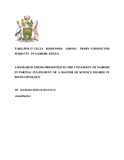| dc.description.abstract | Background: Tuberculosis disease (TB) is caused by Mycobacterium tuberculosis (Mtb). TB leads
to about 2 million deaths annually and remains a major public health burden globally. According
to the WHO report, in 2013 Kenya was ranked 15 out of the 22 countries with high TB burden
globally. Mtb infection clinically exist in two forms, latent TB infection (LTBI) and active infection
(ATB). 5 to 10% of people with LTBI develop active TB during their lifetime, while in the case of
HIV co-infection, the rate is 5-15% annually. Th1-cells subset of CD4 plays a great role of host
defense against Mtb though is not adequate on its own. T helper 17 cells, a newly identified subset
of CD4+T cells, are associated with inflammatory disorders and clearance of extracellular
pathogens, however, their role in the pathogenesis of pulmonary TB in TB/HIV co-infection and
their frequencies is not clearly understood. This study aimed at determining the levels of Th17 cell
responses in HIV/TB co-infected subjects.
Method: A cross-sectional study was conducted among sixty adults visiting TB clinic at Mbagathi
District Hospital and the city council clinics in Nairobi, Kenya. These participants were grouped
as ATB/HIV, ATB, LTBI and controls. After obtaining informed consent, an interferon gamma
release assay was performed and from IGRA supernatants, Th17 milliplex assay was performed to
simultaneously quantify 25 Th17 associated cytokines and chemokines. Responses from the
Antigen minus Nil tubes were analyzed responses with a p value of <0.05 were considered
statistically significant.
Results: Overall antigen specific responses among ATB/HIV co-infected versus ATB alone were
not significant. , IL-17A (p=0.0390), IFN-γ (p=0.0024), MIP3-α (p=0.0362), IL-9(p=0.032), IL-6
(p=0.0459), IL-13(p=0.0079) and IL-5, (p=0.0002) were significantly reduced in ATB/HIV coinfected
compared to LTBI while IFN-γ (p=<0.0001), IL-13(p=0.0029), IL-5(p=0.0013), IL-2
(p=<0.0001), and IL-9(p=0.0069) are significantly reduced in controls as compared to LTBI while
there was no significant difference when the controls were compared to ATB.
Conclusion: This study has indicated that there could be more novel cytokines other than IFN-γ
that can be used to differentiate stages of TB infection. It has also identified Th 17 associated
cytokines that may be incorporated into the current ineffective TB vaccines that have been utilizing
Th1 cells responses to potentiate immunity against TB. Finally, it has shown that HIV does not
seem to further alter these immune responses in advance TB. | en_US |

